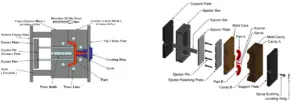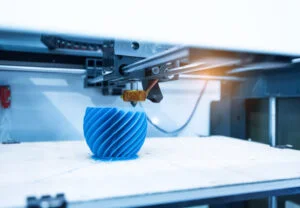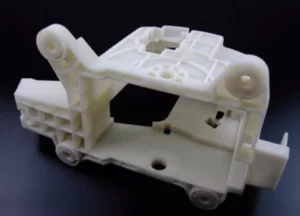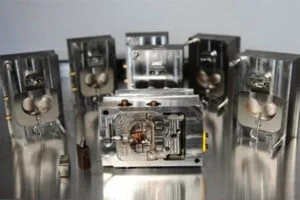Want to know more about how to guide to Bearings work? This guide will explain all you need to know about the definition and purpose of bearing and its uses.
- What is a Bearing?
- The Role and Importance of Bearings in Machinery
- What is the Classification of Bearings?
- Types of Bearings and Their Unique Features
- Examples and Applications of Bearings
- How to Choose the Right Types of Bearing for Your Needs?
- Conclusion
- FAQ
What is a Bearing?
A bearing is a vital mechanical component in the machine industry as it aids rotation between two or more parts of a machine. It is an inside equipment used with shafts to transfer motion and restrict friction. Its intricate design allows mechanical parts to rotate around an axis or move in a linear motion, ensuring smooth operation.
Guide to Bearings are often found in common household devices such as vacuum cleaners and refrigerators. In addition, they are commonly found in machining equipment like Fraisage CNC, drilling machines, etc, because they support the rotation of the shaft.
The Role and Importance of Bearings in Machinery
Although the primary function of bearings is to ensure there is no direct contact between motion elements, there are other roles of bearing. Some of the major roles of guide to Bearings in machinery are:
Facilitate Smooth Motion Or Rotation
One of the major roles of guide to Bearings in machinery is in the reduction of friction between its moving parts, such as the rotating axis and support part. It prevents single-point contact in machines by distributing load across other rolling elements. This reduces wear and tear on the machine while also allowing for a smoother motion.
Increase Efficiency
Bearings are a vital part of machines because they ensure the effective distribution of loads between the moving parts. They increase machine efficiency by reducing the power or energy lost due to friction. It also reduces the friction between the mechanical parts of the machine in motion by supporting the load and other rotating machine components to improve efficiency.
Improve the Longevity and Durability
Because guide to Bearings are available in different shapes and sizes, they are suitable for several types of equipment. This makes them suitable for several machines. It reduces the frequent need for maintenance of those machines.
In addition, bearings increase the lifespan of the machine as they prevent damage or catastrophic failure of the machine. However, it is vital to maintain guide to Bearings to improve the performance of the machinery.
Reduces the Maintenance Costs
Another importance of guide to Bearings in machinery is that they reduce the operating or maintenance costs of the CNC Turning machining. They serve as an economical solution because they reduce the frequency of machine repairs. Since bearings reduce wear and tear on machine components, they improve their performance level.
Ensure the Rotation Shaft is in Place
With bearing, the rotating shaft of the machine is held in place, thereby preventing damage to the support past of the rotator. This, in turn, creates a safe working environment with the machine.

What is the Classification of Bearings?
Bearings are components practically present in all mechanical pieces of equipment. However, they exist in various forms and shapes. Each bearing supports a specific type of movement or motion. The following are the various classifications of guide to Bearings and their examples:
Classification Based on the Type of Friction or Contact
- Rolling contact bearings: It is also known as simply ball bearings or anti-friction bearings. Here, the rollers or spherical balls are put in between the surfaces in motion. They give room for more radial loads.
- Sliding contact bearings: These are also known as journal bearings or sleeve bearings. The moving element or the shaft surface slides the bush, leading to wear and friction. These two surfaces are then separated by a film of lubricating oil to reduce the friction.
Classification Based on the Direction and Type of Load
- Radial bearings: These guide to Bearings support radial loads located perpendicularly to the shaft axis or motion of the moving element. It is a subtype of ball bearings that operates by placing lubricated steel balls between two deep grooved rings.
- Thrust or collar bearings: This mechanical guide to Bearings is also known as axial bearings. They support the load that acts along the motion of the moving element.
Types of Bearings and Their Unique Features
Bearings are of several types, with each having its own applications, and features that help them execute these applications. The following are the various types of guide to Bearings and their features:
Ball Bearing
It is a type of bearing made of spherical parts, such as a rotating shaft and fixed housing cage. These mechanical assemblies are joined together with fasteners, such as nails, rivet types, bolts, screws, and machining threads. The aim is to reduce the friction between them.
Ball bearing is used in several office equipment and industrial machines. They are a type of mechanical device best for frictionless and smooth operations. Ball bearings also support rotatory motion in applications and reduce noise.
This bearing provides good mechanical stability for machines that handle heavy radial and dynamic loads. Ball bearing also consists of four main parts of the common guide to Bearings family, which are:
- The cage
- The shield
- Two rings (Inner and Outer ring)
- The steel balls
Thrust Bearing
Thrust bearing is the best type of bearing used to support axial and thrust loads applied to a shaft. These bearings rotate along the parts of the machine while using balls to support the machine. They glide along the thrust guide to Bearings when the moving parts of the machines rotate.
These bearings are applied in several sectors and applications such as transportation, automotive, industrial machinery, and medical devices. Thrust bearings are highly reliable, available, and can withstand heavy loads.
FootStep Bearing
Footstep bearings or pivot bearings are one of the most common types of guide to Bearings because they support the lower end of vertical shafts. It helps to support shafts that move in axial thrust and are placed vertically. The footstep bearing consists of the following parts:
- The body
- Bearing disc
- Bush
- Locking pin
A major benefit of this type ofguide to Bearings is that it is easy to maintain and dismantle. It has a simple and compact design for assembly which makes it best to use in shafts of steam turbines. Footstep bearing is also used in marine applications such as shafts with less load and speed.
Rolling Contact or Anti-Friction Bearing
A rolling contact bearing has low friction characteristics. They are popularly used for thrust load and radial load simultaneously. It is also designed to be self-aligning and they offer little resistance to movement. The most common types of rolling contact bearings are:
- Cylindrical bearing
- Ball bearing
- Spherical bearing
- Tapered roller bearings
This type of bearing is often applied in the following:
- Medical pieces of equipment
- Aviation cargo systems
- Solar panels
- Engines
- Wind turbines
- Powerhouses
Plain Bearing
Plain guide to Bearings are responsible for preventing wear and tear of the machine at support points. They are the simplest types of bearings that operate based on the principle of sliding friction without rolling elements. Since they have no moving parts, they tend to reduce noise when working. These bearing types are efficient, smooth, and good for heavy loads.
These bearings also accommodate multi-dimensional misalignments and movements. This feature makes it ideal for dynamic and static loads. Plain guide to Bearings are used in linear or rotary applications, construction, marine, and automotive industries.
Linear Bearing
Here, the bearing supports the load at its single-axis linear movement. Linear bearings are fluid-film mechanical devices that reduce friction in motion systems that act along a curved or straight pathway. They have high precision rates, which enable a precise straight motion. Its superior design enables it to accommodate a significant load capacity.
Linear bearing is also self-lubricating and efficient because it operates at a high speed while reducing energy loss. It is applicable in 3D printers, sliding doors, and automation settings.
Fluid Bearing
Fluid bearing enables smooth movement between two materials. It is a fluid-bearing surface that is vital in rotary machines. Fluid guide to Bearings uses fluid to reduce friction between surfaces. This type of bearing adapts easily to moderate misalignment and enables easy removal of calories by fluid. It is often seen in machines that work with heavy loads at higher speeds, such as marine or propeller shafts and hydroelectric plants. They are classified into:
- Hydrostatic bearings
- Hydrodynamic bearings
Jewel Bearing
Jewel bearings are mechanical parts made from gems such as sapphires and rubies, which are hard substances. It has a low coefficient of friction; hence, they do not wear down easily. Their hardness enables them to exhibit high resistance qualities; however, they may be at risk of fracturing due to shocks (radial or axial). This type of bearing is often applicable in clocks, gauges, indicators, and gyros.
Examples and Applications of Bearings
Some examples and applications of bearing are:
- Ball bearings: In the medical industry, this bearing is used in several pieces of equipment or technology. Here, they are vital components in making micro-blood pumps, respirators, and analysis equipment.
- Plain bearings: They are often used in the marine industry to rotate and reciprocate machines transmitting loads through the engine structure. It helps in the marine propulsion systems and the transfer of power.
- Cylindrical roller bearings: This type of bearing is common in the aerospace industry. They are often found in the pumps, engines, and engine gearboxes. It is used in this high-speed application to reduce friction and handle heavy axial loads.
How to Choose the Right Types of Bearing for Your Needs?
Your application will determine what type of bearing it needs. When choosing a bearing to suit your needs, consider the following factors:
Bearing Load
All bearing types have designs that support either a radial or axial load, and some can support both. The axial load is the measurement of the forces acting parallel with the shaft while in radial, they are a right angle to the shaft. When choosing your bearing, consider its load capacity because it determines the right type of bearing you need.
Speed of Rotation
Bearings all have designs that enable them to operate at a certain speed range. This is because not all bearings can withstand high speeds. Look out for guide to Bearings with a cage, such as needle bearings, as they can withstand high speeds. However, check their load capacity as some of these bearings with a cage may not be able to withstand heavy loads.
Temperature
Fluctuating temperature conditions will affect the parts of a rotating system, including bearing components. For example, in a lathe, the circular motion in which the spindle moves, helping to generate energy for whatever type of motion is needed would also create additional heat. guide to Bearings must respond well to this heat from other rotating parts at varying temperatures because they are also sources of heat in a system.
Bearing Longevity and Rigidity
Take note of the rigidity of the bearing before making your choice. You can increase the rigidity of some guide to Bearings by applying the bearing’s preload system. A major benefit of this preload is that it helps to improve the bearing life.
Bearing Lubrication and Sealing
Lubrication helps to prevent overheating, abrasion, and friction in machines because it creates a film of oil. Bad lubrication is one of the major reasons for bearing failure. The sealing system influences the lasting operation of the bearing. A sealed system helps to keep contaminants out of the bearing, thereby preventing bearing failure.
Conclusion
guide to Bearings are a mechanical element that helps to constrain relative motion and reduce friction between moving parts in a machine. It helps to support the rotating shaft of a machine to enable smooth movement. All bearing types have designs that enable them to work at a certain efficiency. When choosing a bearing for your machine, it is vital to check its load capacity, rotation speed, and temperature.
FAQ
How Do I Choose the Best Bearing Type?
There are several factors to consider when choosing the best type of bearing. Ensure to check the load capacity, temperature, rigidity, and rotation speed.
Can I Refurbish My Bearing?
Yes, you can refurbish your bearing. However, it depends on a range of factors. These factors include the maintenance cycles, the environmental influences on the bear, and its accumulated wear.
What is the Cheapest and Simplest Type of Bearing?
The cheapest and simplest type of bearing is plain bearings. This is because it has no moving parts, and it comprises only the bearing and the surface it slides on.








